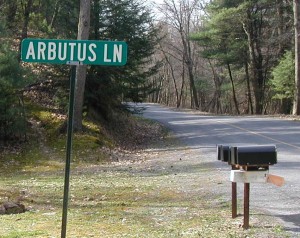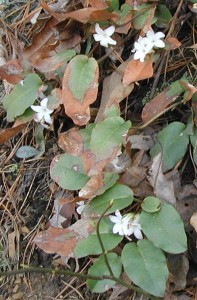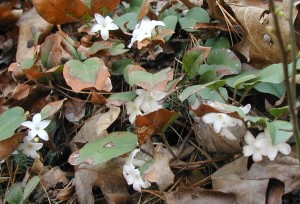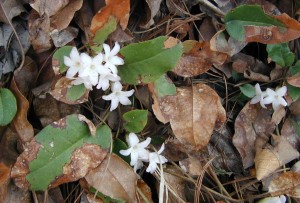I remember reading about the Trailing Arbutus and that it could be found at the Box Huckleberry Natural Area of the Tuscarora State Forest in New Bloomfield, Pennsylvania.
When I took a day-trip over there on 3 April 2010, it took a while to find them. But I finally did!

Near the entrance of the Box Huckleberry Natural Area is a side road called Arbutus Lane. Very close to the spot where Arbutus Lane meets Huckleberry Road is a patch of trailing arbutus. The patch of arbutus we saw was about 2 ft by 3 ft in size under the trees at the border of the State Forest.
Trailing arbutus, Epigaea repens, sometimes called the “Mayflower”, is a member of the heath family, just as the huckleberry is. They do occur in the same habitat, shady places under trees. These perennials both have oval-shaped evergreen leaves, but arbutus leaves are 2-3 times bigger than huckleberry leaves.

Arbutus leaves that last over winter may turn brown at the ends.
Flowers are partially tucked under the old leaves and may not be visible to the casual passerby. Here, the shiny trailing Arbutus blossoms were quite noticeable in the sunlight among the old brown leaves, even though they grew so near the ground.

In the photo above there are four flower clusters, three of which are mostly hidden under the arbutus leaves.
A cluster of two or more, five-petaled, white blossoms appear like partridgeberry blooms with their elongated bell shape. The five petals flare out at the ends of the trumpet-like bell. They also smelled wonderfully sweet.


Now that I’ve seen trailing arbutus I’ll be more likely to spot it in other places, especially when the plant is not blooming.
Peterson’s Medicinal Plants Guide states that Native Americans used a leaf tea to treat kidney and stomach disorders. Arbutus was also used as a folk remedy for urinary problems. Arbutus itself might not be toxic, but a chemical formed in our bodies – as a result of drinking arbutus tea – is toxic. We can’t recommend drinking this tea, so we’ll just admire the trailing arbutus on the trail.